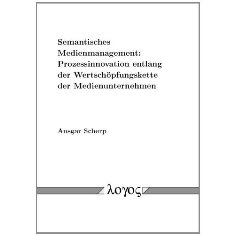 Ansgar Scherp
Ansgar ScherpSummary in English: Media companies such as publishing houses, television broadcasters, radio stations, media archives, and libraries are facing a couple of challenges regarding the creation, indexing, and usage of media content. These challenges are a poor indexing of the media content, low visibility of media stocks in the Internet, limited search within the media stocks, and lack of process integration. Today's media management solutions cannot sufficiently address these challenges. The core reason for these problems is the solely use of textual metadata for indexing and using the media content. Annotations based on textual metadata are prone to, e.g., typographical errors, variant forms of spelling, and ambiguities. To address these challenges and to alleviate the problems of the media companies, a semantic media management has been developed over the last years. Semantic media management is the management of media content by technologies of the Semantic Web. Central part is the use of a formal metadata model that is based on core ontologies and Linked Data. Such a formal metadata model provides support for a comprehensive and precise description of the semantics of digital media content. The use of this metadata model allows for technical innovations in the different processes of media management. In addition, it enables better integration of the processes.
Zusammenfassung in Deutsch: Medienunternehmen wie Verlage, Fernsehsender, Radiostationen, Medienarchive und Bibliotheken stehen hinsichtlich der Erstellung, Erschließung und Nutzung von Medieninhalten einer Reihe von Herausforderungen gegenüber, die von heutigen Medienmanagementsystemen nicht gelöst werden. Diese Herausforderungen sind eine mangelnde Erschließung der Medieninhalte, geringe Sichtbarkeit der Medienbestände im Internet, schlechte Durchsuchbarkeit der Medienbestände und eine fehlende Prozessintegration. Zentrale Ursache für diese Probleme ist die Verwendung von ausschließlich textuellen Metadaten zur Erschließung und Nutzung der Medieninhalte. Annotationen mittels textueller Metadaten sind anfällig gegenüber beispielsweise Tippfehlern, alternativen Schreibweisen und Mehrdeutigkeiten. Um die Herausforderungen anzugehen und die Probleme der Medienunternehmen zu mildern wurde in den vergangenen Jahren der Lösungsansatz eines semantischen Medienmanagements entwickelt. Unter dem semantischen Medienmanagement wird das Management von Medieninhalten mit Hilfe von Technologien des Semantic Web verstanden. Kern dieses Ansatzes ist die Verwendung eines formalen Metadatenmodells, dass auf Kernontologien und Linked Data basiert und zur umfassenden und präzisen Beschreibung der Semantik digitaler Medieninhalte genutzt werden kann. Es wird aufgezeigt, wie durch den Einsatz dieses Metadatenmodells technische Innovationen in den einzelnen Prozessschritten des Medienmanagements erreicht und die Prozessschritte besser integriert werden können. Ziel ist es ein effizienteres und kostengünstigeres Management der Medieninhalte zu ermöglichen.
The results of the habilitation thesis became among others part of the development and founding of the startup company Kreuzverweis Solutions GmbH. The company develops tools and services for semantic media management.
[J5] S. Schenk, C. Saathoff, S. Staab, and A. Scherp: SemaPlorer—Interactive Semantic Exploration of Data and Media based on a Federated Cloud Infrastructure, Journal of Web Semantics, Elsevier, 7(4), 2009. [PDF] [Publisher]
[J4] A. Scherp and R. Jain: Introducing an ecosystem for semantics, IEEE Multimedia, IEEE, 16(2), 2009. [PDF] [Publisher]
[J3] A. Scherp: Canonical Processes for Creating Personalized Semantically-rich Multimedia Presentations, Multimedia Systems, 14(6), 2008. ISSN 0942-4962 [PDF] [Publisher]
[J2] A. Scherp, S. Boll, and H. Cremer: Emergent Semantics in Personalized Multimedia Content, J. of Digital Information Management, Digital Information Research Foundation, 5(2):55-60, April 2007. ISSN 0972-7272 [PDF] [Publisher]
[J9] A. Scherp, C. Saathoff, T. Franz, and S. Staab: A Core Ontology on Events for the Semantic Representation of Human Experiences in the Real World, Multimedia Tools and Applications, Springer, 58(2):293-331, 2012. [PDF] [Publisher]
[J8] A. Scherp, C. Saathoff, T. Franz, and S. Staab: Designing Core Ontologies, Applied Ontology, IOS Press, 3(6):177-221, 2011. [PDF] [Publisher]